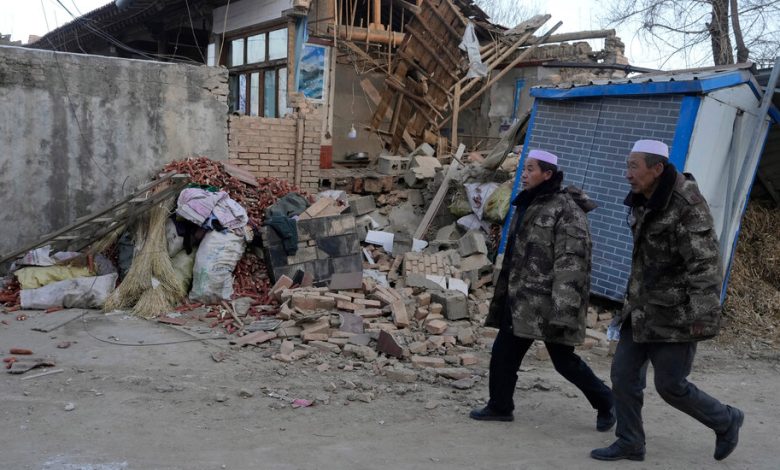In Bitter Cold, Rescuers Struggle to Help Quake Survivors in China

Rescue workers strained to plow through eight-foot piles of frozen sludge, which blocked the entrances to destroyed villages. Emergency vehicles struggled to navigate icy, damaged mountain roads. Victims with serious injuries were rushed to hospitals in cities, as demand for medical care overwhelmed the villages’ limited capacities.
In the wake of China’s deadliest earthquake in nearly a decade, emergency workers raced to find survivors and distribute aid in Jishishan County in China’s northwest. They were running up against the challenges of rescue work in bitter cold in a remote part of Gansu, one of China’s poorest provinces.
The quake, which hit late Monday night, killed at least 131 people, most in Gansu but some in neighboring Qinghai Province, according to official tallies updated on Wednesday. The death toll had risen from 120 the day before, and the window for rescuing survivors — shorter than usual due to the freezing conditions, experts said — had narrowed.
More than 87,000 people had been temporarily resettled as of Wednesday morning, Gansu officials said at a news conference. Photos in state media showed rows of blue tents erected at three main resettlement sites across the county, where residents wrapped in thick coats huddled around vehicles equipped with power outlets to charge their phones, or lined up for bowls of hot food. Others lit bonfires in the street to keep warm.
When the quake struck, according to state media, temperatures in Jishishan, a rural and mountainous cluster of towns and villages home to about a quarter of a million people, were at nearly -20 degrees Celsius, or -4 degrees Fahrenheit, part of a cold spell that has gripped much of China. The quake had a magnitude of 5.9, according to the United States Geological Survey, though the China Earthquake Administration put it at 6.2.
“Gansu earthquake: The worst time, the most vulnerable place” was a trending phrase on Chinese social media on Wednesday. Temperatures remained cold on Wednesday, with lows of around -16 degrees Celsius, or 3 degrees Fahrenheit.
The quake injured at least 980 people and damaged more than 200,000 buildings, officials said. One of the worst-hit towns, called Dahejia, exemplified the challenges facing rescuers and survivors.
More than 80 percent of houses in the village were now uninhabitable, a local official told Xinhua, a state news agency. Many of the houses had been made of earth, and some were more than a century old, making them especially vulnerable, one rescue worker said. Jishishan County had been considered “poverty-stricken” until 2020, one of the last areas in China to be supposedly lifted out of poverty as part of a nationwide campaign. It is home to ethnic minorities including the Bonan, Dongxiang and Salar people, many of whom are Muslim.
The county did not have enough clothes, quilts or shoes to distribute to residents and would need to rely on outside aid, a local official said on Tuesday.
Some residents who had rushed out into the midnight cold when the quake struck still had only the few layers they’d managed to grab in the dark.
Ye Jinmo, a restaurant owner in Dahejia who was sheltering with her husband and four teenage children in a government-supplied tent, said by telephone on Wednesday morning that the government had not yet begun handing out clothing, though she had seen many supplies arriving.
“All I’m wearing is what I wore outside during the earthquake,” she said.
Still, the tent had a stove to provide warmth, and officials had distributed noodles, Ms. Ye said.
Many of the relief efforts were concentrated on Dahejia, and some people in other villages were still waiting for aid on Wednesday. Because of tent shortages, some villagers elsewhere in Jishishan spent the night in their cars, or in shacks they built themselves, according to Caixin, a Chinese news outlet.
In the town of Chuimatan, about 16 miles from Dahejia, some residents whose roofs were now gaping open could only stay with relatives whose homes were more intact, or shelter in restaurants or public buildings, said Ma Zhanguo, a resident there. No tents or other aid had been distributed there yet, said Mr. Ma, who said his own apartment building had sustained cracks but was still inhabitable.
“No one has time to think about repairs. Just escaping with your life is the most important thing,” he said. “The government is busy elsewhere. Here, people figure out themselves where to go at night.”
In Qinghai Province, where 18 of the deaths occurred, rescuers were grappling with landslides triggered by the earthquake. Some buildings were buried in soil that had been liquefied by the tremors, then froze again in the low temperatures, The Paper, a Communist Party-affiliated news site, reported. Workers had to use excavators to try and clear the mud, and to pave paths through the mud with stones and firewood.
Officials said on Wednesday that rescue work had largely finished, and that their efforts would turn primarily to treatment of the injured and to resettlement. At the news conference on Wednesday, Gansu officials said that electricity and water had been restored to all of Jishishan.
Still, in the middle of the news conference, which was being live-streamed by the state broadcaster CCTV, the video cut out. An anchor explained that the power supply at the site was unstable.
The authorities were also working to maintain order in other, more punitive ways. Local officials said they had detained two men after they said online that an aftershock even stronger than the initial quake was going to occur. The men were sentenced to five days in detention.
China’s last earthquake with a higher death count was in 2014 in southwestern Yunnan Province, where 617 people died. The government honed its rescue and relief efforts after a 7.9-magnitude earthquake in Sichuan Province, not far from Gansu, killed around 90,000 people in 2008.
Siyi Zhao contributed research from Seoul.




